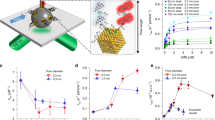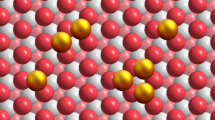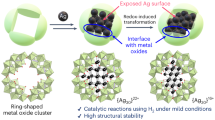Abstract
The active sites of enzymes are contained within nanoscale environments that exhibit exquisite levels of specificity to particular molecules. The development of such nanoscale environments on synthetic surfaces, which would be capable of discriminating between molecules that would nominally bind in a similar way to the surface, could be of use in nanosensing, selective catalysis and gas separation. However, mimicking such subtle behaviour, even crudely, with a synthetic system remains a significant challenge. Here, we show that the reactive sites on the surface of a tetrairidium cluster can be controlled by using three calixarene–phosphine ligands to create a selective nanoscale environment at the metal surface. Each ligand is 1.4 nm in length and envelopes the cluster core in a manner that discriminates between the reactivities of the basal-plane and apical iridium atoms. CO ligands are initially present on the clusters and can be selectively removed from the basal-plane sites by thermal dissociation and from the apical sites by reactive decarbonylation with the bulky reactant trimethylamine-N-oxide. Both steps lead to the creation of metal sites that can bind CO molecules, but only the reactive decarbonylation step creates vacancies that are also able to bond to ethylene, and catalyse its hydrogenation.
This is a preview of subscription content, access via your institution
Access options
Subscribe to this journal
Receive 12 print issues and online access
$259.00 per year
only $21.58 per issue
Buy this article
- Purchase on Springer Link
- Instant access to full article PDF
Prices may be subject to local taxes which are calculated during checkout





Similar content being viewed by others
References
Khersonsky, O. & Tawfik, D. S. Enzyme promiscuity: a mechanistic and evolutionary perspective. Annu. Rev. Biochem. 79, 471–505 (2010).
Schultz, P. G. & Lerner, R. A. From molecular diversity to catalysis: lessons from the immune system. Science 269, 1835–1842 (1995).
O'Brien, P. J. & Herschlag, D. Functional interrelationships in the alkaline phosphatase superfamily: phosphodiesterase activity of Escherichia coli alkaline phosphatase. Biochemistry 40, 5691–5699 (2001).
Quintanar, L. et al. Spectroscopic and electronic structure studies of the trinuclear Cu cluster active site of the multicopper oxidase laccase: nature of its coordination unsaturation. J. Am. Chem. Soc. 127, 13832–13845 (2005).
Marshall, S. T. et al. Controlled selectivity for palladium catalysts using self-assembled monolayers. Nature Mater. 9, 853–858 (2010).
Corma, A. et al. Preparation, characterisation and catalytic activity of ITQ-2, a delaminated zeolite. Microporous Mesoporous Mater. 38, 301–309 (2000).
Wulff, G., Heide, B. & Helfmeier, G. Enzyme-analogue built polymers. 24. On the distance accuracy of functional groups in polymers and silicas introduced by a template approach. React. Polym. Ion Exch. Sorbents 6, 299–310 (1987).
Mondloch, J. E., Bayram, E. & Finke, R. G. A review of the kinetics and mechanisms of formation of supported-nanoparticle heterogeneous catalysts. J. Mol. Catal. A 355, 1–38 (2012).
Oliver-Meseguer, J., Cabrero-Antonino, J. R., Domínguez, I., Leyva-Pérez, A. & Corma, A. Small gold clusters formed in solution give reaction turnover numbers of 10(7) at room temperature. Science 338, 1452–1455 (2012).
Herzing, A. A., Kiely, C. J., Carley, A. F., Landon, P. & Hutchings, G. J. Identification of active gold nanoclusters on iron oxide supports for CO oxidation. Science 321, 1331–1335 (2008).
Takei, T. et al. in Advances in Catalysis vol. 55, 1–126 (Academic, 2012).
Okrut, A. et al. Stabilization of coordinatively unsaturated Ir4 clusters with bulky ligands: a comparative study of chemical and mechanical effects. Dalton Trans. 41, 2091–2099 (2012).
De Silva, N. et al. A bioinspired approach for controlling accessibility in calix[4]arene-bound metal cluster catalysts. Nature Chem. 2, 1062–1068 (2010).
Nigra, M. M. et al. Accessible gold clusters using calix[4]arene N-heterocyclic carbene and phosphine ligands. Dalton Trans. 42, 12762–12771 (2013).
Sonnenberger, D. C. & Atwood, J. D. Labilization of carbon monoxide dissociation from metal clusters: an investigation of the substitution reactions of monosubstituted derivatives of tetrairidium, Ir4(CO)11L (L=PBu3, PPh3, AsPh3, and P(OPh)3). J. Am. Chem. Soc. 104, 2113–2126 (1982).
Darensbourg, D. J. & Baldwin-Zuschke, B. J. Ligand substitution processes in tetranuclear carbonyl clusters. 6. Steric contribution to ligand dissociation in multisubstituted tetrairidium dodecacarbonyl derivatives. J. Am. Chem. Soc. 104, 3906–3910 (1982).
Argo, A. M., Odzak, J. F., Lai, F. S. & Gates, B. C. Observation of ligand effects during alkene hydrogenation catalysed by supported metal clusters. Nature 415, 623–626 (2002).
Lu, J., Serna, P., Aydin, C., Browning, N. D. & Gates, B. C. Supported molecular iridium catalysts: resolving effects of metal nuclearity and supports as ligands. J. Am. Chem. Soc. 133, 16186–16195 (2011).
Ros, R., Scrivanti, A. & Roulet, R. Synthesis and stereochemistry of mono- and di-olefin derivatives of tetrairidium carbonyl clusters. J. Organomet. Chem. 303, 273–282 (1986).
Petrova, G. P., Vayssilov, G. N. & Rösch, N. Interaction of ethene and ethyne with bare and hydrogenated Ir4 clusters. A density functional study. Catal. Sci. Technol. 1, 958–970 (2011).
Peterson, A. A. & Nørskov, J. K. Activity descriptors for CO2 electroreduction to methane on transition-metal catalysts. J. Phys. Chem. Lett. 3, 251–258 (2012).
Wang, H. & Iglesia, E. Thiophene hydrodesulfurization catalysis on supported Ru clusters: mechanism and site requirements for hydrogenation and desulfurization pathways. J. Catal. 273, 245–256 (2010).
Santi, D., Holl, T., Calemma, V. & Weitkamp, J. High-performance ring-opening catalysts based on iridium-containing zeolite beta in the hydroconversion of decalin. Appl. Catal. A 455, 46–57 (2013).
Hortmann, K. Process for reducing carbon monoxide in olefin-containing hydrocarbon feedstocks. Patent application US 2010/0234662 (20 June 2008).
Kennedy, J. R., Selz, P., Rheingold, A. L., Trogler, W. C. & Basolo, F. Periodic trends and ligand effects in the substitution labilities of tetrametal cluster complexes of the cobalt triad. Molecular structure of Rh4(CO)8{HC[P(C6H5)2]3}[P(OC2H5)3]. J. Am. Chem. Soc. 111, 3615–3627 (1989).
Elzinga, J. & Hogeveen, H. Intermediate complex in the reduction of trimethylamine oxide by pentacarbonyl iron: its use as catalyst in the addition of carbon tetrachloride to carbon–carbon double bonds. J. Chem. Soc. Chem. Commun. 705–706 (1977).
Hasse, W., Günter, H-L. & Henzler, M. Study of self-hydrogenation of ethene on clean Ni(111). Surf. Sci. 126, 479–486 (1983).
Tilekaratne, A., Simonovis, J. P., López Fagúndez, M. F., Ebrahimi, M. & Zaera, F. Operando studies of the catalytic hydrogenation of ethylene on Pt(111) single crystal surfaces. ACS Catal. 2, 2259–2268 (2012).
Öfner, H. & Zaera, F. Ethylene adsorption on platinum: kinetics, bonding, and relevance to catalysis. J. Am. Chem. Soc. 124, 10982–10983 (2002).
Hwu, H. H., Eng, J. & Chen, J. G. Ni/Pt(111) bimetallic surfaces: unique chemistry at monolayer Ni coverage. J. Am. Chem. Soc. 124, 702–709 (2002).
Newell, H. E., McCoustra, M. R. S., Chesters, M. A. & De La Cruz, C. The thermal chemistry of adsorbed ethyl on the Pt(111) surface: infrared evidence for an ethylidene intermediate in the ethyl to ethylidyne conversion. J. Chem. Soc. Faraday Trans. 94, 3695–3698 (1998).
Green, I. X., Buda, C., Zhang, Z., Neurock, M. & Yates, J. T. IR spectroscopic measurement of diffusion kinetics of chemisorbed pyridine through TiO2 particles. J. Phys. Chem. C 114, 16649–16659 (2010).
Aubart, M. A. & Pignolet, L. H. The catalysis of hydrogen–deuterium equilibration by platinum–gold cluster compounds. J. Am. Chem. Soc. 114, 7901–7903 (1992).
Cortright, R., Goddard, S., Rekoske, J. & Dumesic, J. Kinetic study of ethylene hydrogenation. J. Catal. 127, 342–353 (1991).
Argo, A. M. et al. Catalysis by oxide-supported clusters of iridium and rhodium: hydrogenation of ethene, propene, and toluene. J. Phys. Chem. B 110, 1775–1786 (2006).
Acknowledgements
The authors acknowledge financial support from the Management and Transfer of Hydrogen via Catalysis Program funded by Chevron Corporation (to A.O. and X.O.) and the US Department of Energy, Office of Science, Basic Energy Sciences (contract no. DE-SC0005822, to J.L., C.A., B.G., R.R., A.K., S.Z. and D.D.). The NMR facility at Caltech was supported by the National Science Foundation (NSF; grant no. 9724240) and partially supported by the MRSEC Program of the NSF (award no. DMR-520565; to S.H.). Electron microscopy work was supported by the Department of Energy (DOE; Basic Energy Sciences grant no. DE-FG02-03ER46057, to C.A.) and the University of California Lab Fee Program. The Molecular Graphics and Computation Facility at UC Berkeley was supported by the NSF (award no. CHE 0840505, to O.O. and K.D.).
Author information
Authors and Affiliations
Contributions
A.O., B.G. and A.K. conceived and designed the experiments and co-wrote the paper. A.O. synthesized all materials and performed solution-phase experiments and analysed spectroscopic data. R.R. performed ethylene hydrogenation experiments and analysed the data. X.O. performed the in situ FTIR experiments and analysed the data. J.L. performed the H2/D2 exchange experiment and analysed the data. C.A. performed scanning transmission electron microscopy experiments and analysed the data. O.O., S.Z., K.D. and D.D. performed molecular modelling studies and analysed the data. S.H. performed solid-state NMR experiments and analysed the data. All authors discussed the results and commented on the manuscript.
Corresponding authors
Ethics declarations
Competing interests
The authors declare no competing financial interests.
Supplementary information
Supplementary information
Supplementary Information (PDF 1462 kb)
Rights and permissions
About this article
Cite this article
Okrut, A., Runnebaum, R., Ouyang, X. et al. Selective molecular recognition by nanoscale environments in a supported iridium cluster catalyst. Nature Nanotech 9, 459–465 (2014). https://doi.org/10.1038/nnano.2014.72
Received:
Accepted:
Published:
Issue Date:
DOI: https://doi.org/10.1038/nnano.2014.72
This article is cited by
-
Theoretical investigation of copper clusters using the electron propagator theory
Journal of Chemical Sciences (2023)
-
Dual-atom Pt heterogeneous catalyst with excellent catalytic performances for the selective hydrogenation and epoxidation
Nature Communications (2021)
-
Atomically-precise dopant-controlled single cluster catalysis for electrochemical nitrogen reduction
Nature Communications (2020)
-
Generation of subnanometric platinum with high stability during transformation of a 2D zeolite into 3D
Nature Materials (2017)
-
The MOF-driven synthesis of supported palladium clusters with catalytic activity for carbene-mediated chemistry
Nature Materials (2017)



